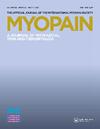Multiple Sclerosis Presenting with Parsonage–Turner Syndrome: A Case Report
引用次数: 1
Abstract
Abstract Background: A case of Parsonage–Turner syndrome [PTS] with typical sudden onset of shoulder pain and weakness in shoulder girdle was presented. Findings: Electrodiagnostic testing revealed an upper trunk lesion. Further diagnostic steps were pursued because of medical history and additional clinical findings. Hyperintense plaques typical of multiple sclerosis [MS] were revealed by cranial magnetic resonance imaging. Diagnosis of clinically definite MS was establised according to the McDonald criteria. Conclusions: A variety of peripheral nervous system pathologies might coexist with MS with unknown binding pathogenesis. This is an unusual case of PTS coexisting with MS as the presenting symptom.多发性硬化症表现为牧师-特纳综合征:1例报告
摘要背景:本文报告1例以突发性肩痛、肩带无力为典型表现的帕森纳-特纳综合征(PTS)。结果:电诊断检查显示上躯干病变。由于病史和其他临床发现,采取了进一步的诊断步骤。颅磁共振成像显示多发性硬化症(MS)典型的高强度斑块。根据McDonald标准建立临床明确的MS诊断。结论:多发性硬化症可能伴有多种周围神经系统病变,结合机制不明。这是一个罕见的PTS并发多发性硬化症的病例。
本文章由计算机程序翻译,如有差异,请以英文原文为准。
求助全文
约1分钟内获得全文
求助全文

 求助内容:
求助内容: 应助结果提醒方式:
应助结果提醒方式:


